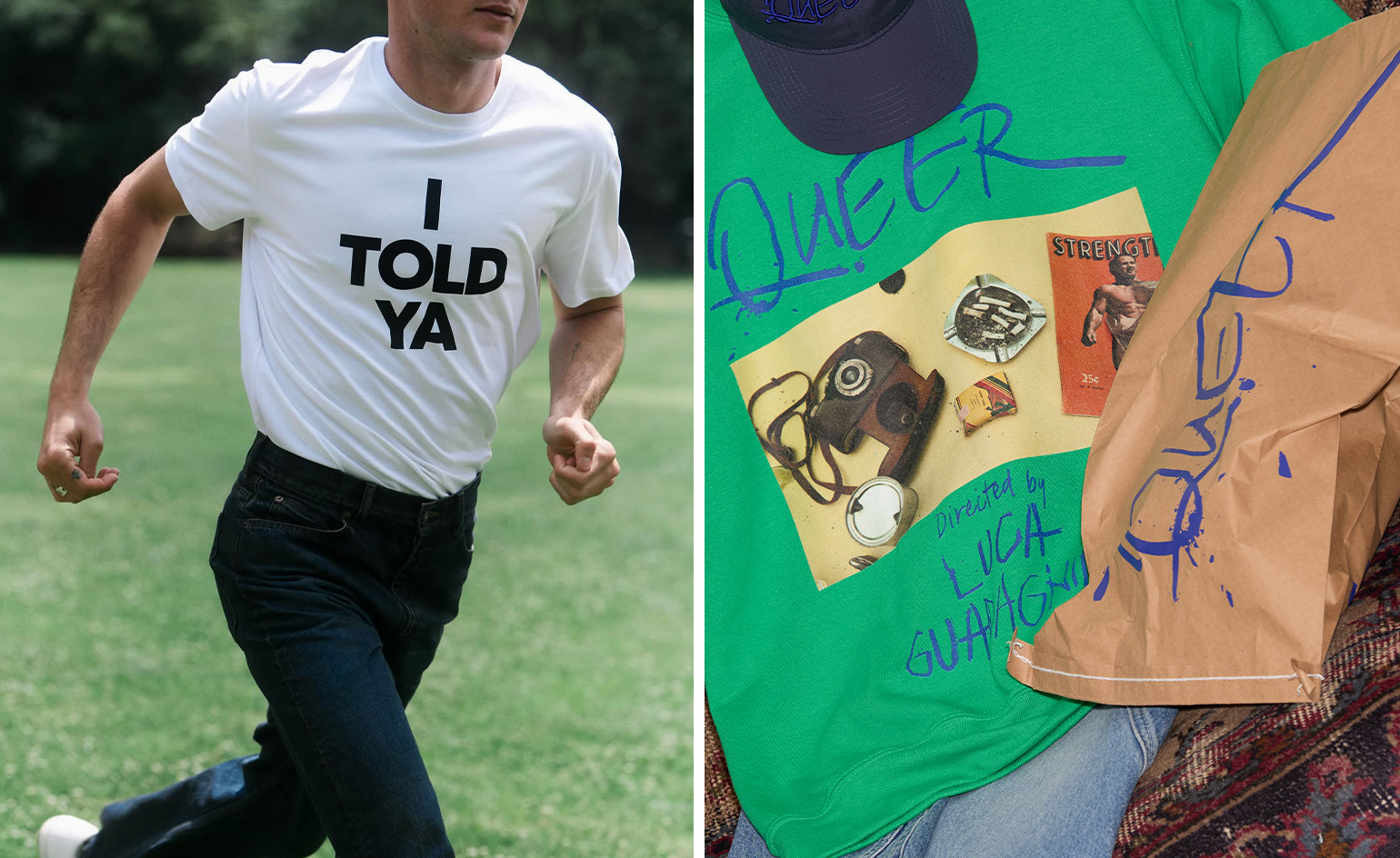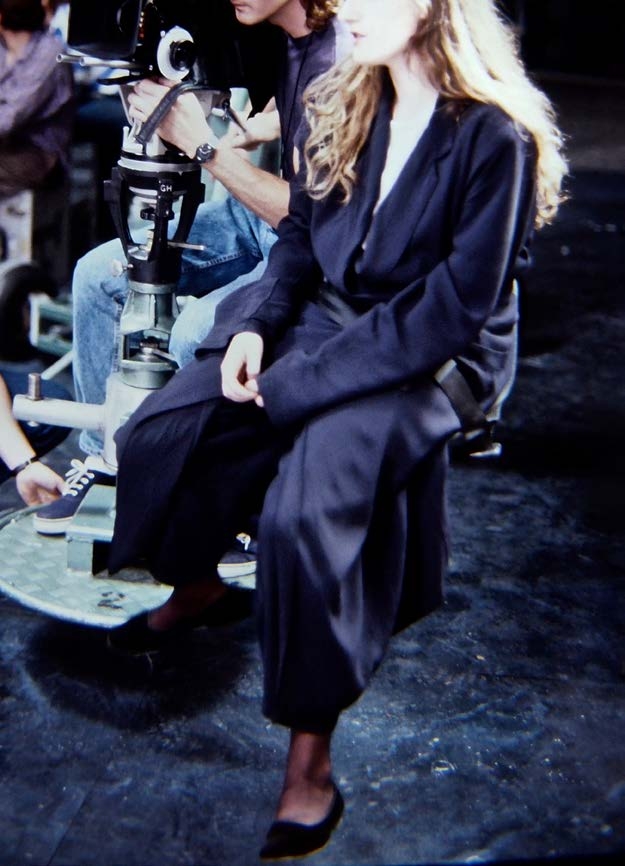‘It’s the new band T-shirt’: Why movie merch took over fashion in 2024
2024 was the year that the movie tee became the new band T-shirt, with fashion labels both established and emerging creating merch collections inspired by cinema, from Challengers’ viral ‘I Told Ya’ tee to the rise of Hagop Kourounian’s @directorfits. Reporting for Wallpaper*, Mary Cleary finds out why

‘I Told Ya’ reads the T-shirt worn by Zendaya and Josh O’Connor in the Luca Guadagnino-directed tennis movie Challengers, released in April of this year. The shirt, a replica of one worn by John F Kennedy Jr in the 1990s, was recreated in the film by British designer Jonathan Anderson, creative director of Loewe and JW Anderson. Here, he was working in a new role: costume designer, one which he would continue on Guadagnino’s second movie of 2024, Queer (released this December).
The T-shirt, which would retail on Loewe’s website for £225, took on a life of its own after the movie, worn by the film’s stars on the press tour and becoming ubiquitous on social media streams (it would also make for a particularly popular Halloween costume come October). Quite what the T-shirt was ‘telling’ us – in the film, the T-shirt swaps between Zendaya’s Tashi and O’Connor’s Patrick Zweig, seeming to symbolise who is holding power in their relationship – one message seemed loud and clear: movie merch is now high-fashion.
Why movie merch took over fashion in 2024

JW Anderson’s ‘Queer’ capsule collection, designed by Jonathan Anderson
Speaking about his inspirations for the film’s costumes, Anderson said his designs were born from an obsession with how ‘the relationship between youth culture and clothing and sport changed’. Switch in the word ‘cinema’ for ‘sport’ and the statement is just as valid. Because while fashion has always been obsessed with film, and film with fashion, the symbiotic relationship seemed to take on new dimensions in 2024 – both with the adoption of the themed red carpet press tour (which began with Barbie in 2023 and continued with Dune, Challengers and Wicked), but also a flood of movie-branded T-shirts, caps and tote bags from fashion labels both big and small.
‘Brands really have become a phenomenon that’s always around us,’ says the ever-perceptive Anderson, whose own shift to costume design will no doubt spark a trend among other designers (indeed, Gareth Pugh has designed costumes for Danny Boyle’s 28 Years Later, released in 2025). ‘Ultimately, the style of Challengers in terms of costume design was looking at life and how we are surrounded and bombarded by all of that.’ If movies are brands too, Anderson seems to be saying, then why not allow people to buy into that brand through the clothes they wear?
It’s a savvy approach and one Anderson is continuing on Guadagnino's latest film, Queer. In addition to creating the costumes for the film, Anderson has released a Queer capsule collection through his eponymous label JW Anderson that includes bags, shirts and baseball caps emblazoned with the film’s logo, stills from the set and the quote ‘I want to speak to you…without speaking’. And, if you need even further proof of Anderson’s embrace of the movie industry just look at Loewe’s Spring 2025 campaign, which featured Amazon MGM Studios marketing chief Sue Kroll as a model.
A post shared by Copycat Video Press (@copycatvideopress)
A photo posted by on
But Anderson isn’t the only designer finding creative ways to unite fashion and film. Plenty of smaller retailers are putting their own spin on movie merch. The limited-run screen printing studios Copycat Video Press and Till Death Press have made T-shirts featuring vintage advertisements, from Eraserhead to The Lost Boys, alongside odes to H.G. Giger and Alejandro Jodorowsky. Most recently, they collaborated on a T-shirt featuring the poster for Michael Haneke’s gruesome house invasion thriller Funny Games (‘sometimes losing your life can be fun,’ it reads). Then there is Cinegogue Shop, which creates limited-run T-shirts, sweatshirts and totes inspired by auteur classics like Paris, Texas and There Will Be Blood. Most recently, the brand collaborated with independent music magazine Synth Histories on a limited-edition shirt inspired by the soundtrack for Twin Peaks, and also with Focus Features on limited edition sweatshirts for Robert Eggers’ new Nosferatu movie.
Alongside Focus Features, other production companies like A24 are also partnering with niche labels to create merch, which often bolsters the films’ cult appeal. An ongoing collaboration with Los Angeles streetwear label Online Ceramics has seen them create (among others) a Love Lies Bleeding beach towel, a Spring Breakers tie-dye shirt and a MaXXXine thong all rendered in Online Ceramics’ signature trippy, DIY style. Streaming platform and distributor Mubi also has a longtime relationship with fashion, inviting designers like Hedi Slimane to create a watchlist for the website and working with Chanel on a prize to award the next generation of filmmakers. More recently, it has also started selling merchandise for its films including a baseball cap, T-shirt and water bottle for the Demi Moore-starring body horror The Substance.
Wallpaper* Newsletter
Receive our daily digest of inspiration, escapism and design stories from around the world direct to your inbox.
A photo posted by on
In a way, it seems movie merch like this is on its way to becoming the new band T-shirt – a straightforward, easy-to-wear way of announcing your cultural allegiances. Hagop Kourounian, who runs the popular Instagram @directorfits and creates his own distinctive movie merch – including collaborating with Mubi on The Substance capsule – thinks that the fashionability of movie merch has to do with people’s desire to single themselves out from the crowd; to distinguish their personal brand from any other. ‘It seems like showing off your niche personal interests is what is mainstream now,’ he says. ‘We’ve sort of shifted away from a monoculture to this new thing where showing off your random obsession is what’s cool and makes you “unique”.’
‘I think band T-shirts for a while now have transcended their fan bases to becoming iconic logos themselves,’ Kourounian continues. ‘You don’t need to be a Nirvana fan or a Rolling Stones fan to wear their merch, it’s readily available at fifteen stores at any given mall in the world, so it doesn’t really showcase one’s individuality. They’ve sort of lost meaning with the fanbases that made them who they are, while film merch still has this somewhat niche allure to it that makes it attractive to showcasing your personality.’
Still, Kourounian points out, it’s worth remembering that the symbiotic relationship between fashion and films has always existed. ‘I have this not so fleshed out theory that film directors and fashion designers secretly want to be one another,’ he says. ‘They’re both world builders and storytellers just with different mediums. Both art forms utilise the other's materials to a certain extent. Fashion shows have wild visuals and scores while films have dedicated costume designers to help push along the narrative.’
A post shared by 🔎 (@directorfits)
A photo posted by on
On Instagram, Kourounian has established himself as a veritable historian of cinema and fashion, and his knowledge is on show when I ask him about the history of fashion brands embracing movie merchandising. ‘The first collection Supreme offered at their first flagship store in NYC back in 1994 featured Martin Scorsese’s Taxi Driver, Fuct has an iconic Goodfellas logo flip, brands like Undercover have been referencing Stanley Kubrick and David Lynch for over a decade,’ he tells me. ‘Giorgio Armani was essentially introduced to the world through the popularity of Paul Schrader’s American Gigolo and Martin Scorsese made a wonderful documentary on the designer called Made in Milan. Going back even further, Yves Saint Laurent was designing costumes for Catherine Deneuve in Luis Buñuel's Belle de Jour back in 1967.’
Kourounian was an editor of the book How Directors Dress, which was released by A24 earlier this year and proves that directors are as influential on fashion as the movies they make. Flipping through its pages you will find plenty of directors with out-of-the-box style – Dennis Hopper on the set of Easy Rider in full cowboy getup, Rainer Werner Fassbinder in tops too tight to contain his belly, and Wong Kar-wai in sunglasses with ‘true colour’ lenses originally used by pilots who needed to see clearly but avoid strong sunlight.

The cover image from A24’s How Directors Dress, featuring Joanna Hogg wearing Yohji Yamamoto on the set of Flesh + Blood, 1987.
But what is most striking is how many directors are dressed in what is now the obligatory uniform of stylish urbanites. Spike Lee, Steven Spielberg, Paul Schrader and more all look like guys you see hanging around the Lower East Side or east London today with their baseball caps, baggy jeans, sneakers and oversized jackets. It is a style born out of functionality that has since come to represent the creative act, no doubt in part because people like Spielberg and Schrader helped make it the uniform of creatives at work. As Adam Wray writes in one of the book’s essays, ‘we are attracted to action, and the utilitarian clothes worn by directors and their crews can help us to better understand the efforts poured into shaping these fictive worlds.’
Even though, as Kourounian points out, iconic designers like Yves Saint Laurent have designed costumes in the past, Anderson has set a new precedent by transforming his work on Challengers and Queer into products his customers can buy. It raises the question, then, if other designers will follow suit. Will we see someone like Miuccia Prada selling designs for longtime collaborator Wes Anderson through Prada or Miu Miu, or Yohji Yamamoto selling clothes he’s created for a film by Steve McQueen, who has walked his runway a number of times? And what about the directors themselves? Sofia Coppola has already capitalised on her iconic style by creating pieces for the luxury cashmere house Barrie and it stands to reason that, as the relationship between film and fashion becomes increasingly intertwined, more directors will turn their iconic personal style into items you can buy. Could you one day buy Spike Lee varsity jackets, or a Steven Spielberg-designed baseball cap? How it will continue to play out is yet to be seen, but one thing is almost certain: movie merch will continue to take over fashion. We told ya.
‘How Director’s Dress’, published by A24, is available from shop.a24films.com.
Queer is in UK cinemas now.
Mary Cleary is a writer based in London and New York. Previously beauty & grooming editor at Wallpaper*, she is now a contributing editor, alongside writing for various publications on all aspects of culture.
-
 All-In is the Paris-based label making full-force fashion for main character dressing
All-In is the Paris-based label making full-force fashion for main character dressingPart of our monthly Uprising series, Wallpaper* meets Benjamin Barron and Bror August Vestbø of All-In, the LVMH Prize-nominated label which bases its collections on a riotous cast of characters – real and imagined
By Orla Brennan
-
 Maserati joins forces with Giorgetti for a turbo-charged relationship
Maserati joins forces with Giorgetti for a turbo-charged relationshipAnnouncing their marriage during Milan Design Week, the brands unveiled a collection, a car and a long term commitment
By Hugo Macdonald
-
 Through an innovative new training program, Poltrona Frau aims to safeguard Italian craft
Through an innovative new training program, Poltrona Frau aims to safeguard Italian craftThe heritage furniture manufacturer is training a new generation of leather artisans
By Cristina Kiran Piotti